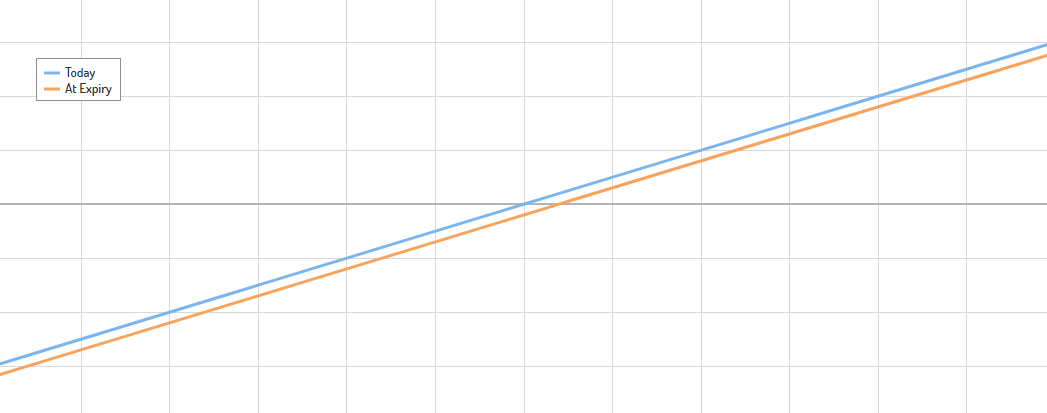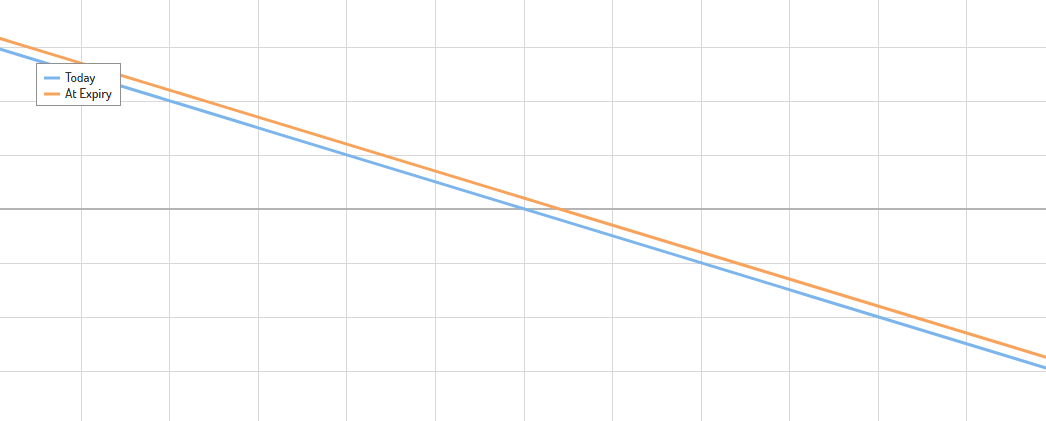Synthetic stocks are a specific kind of option stock strategy. The idea is to mimic the payoff of a normal stock, but without owning the stock. This very simple to set up strategy will act like a stock position but is created with options alone. Due to the leverage that options have, this will be cheaper than buying and holding the actual underlying stock. This is a good alternative to stocks and is a great transition from stock trading to option trading. The following article will be a breakdown of this option strategy:
Synthetic Long Stock

Market Assumption:
As you maybe know by now and can clearly see on the payoff diagram above, this option spread has the exact payoff of a normal long stock position. This is also the reason why it is called synthetic stock. It acts like a stock but is made out of options. The market assumption of a normal long stock position would be a bullish one: the more bullish, the better. Logically, the market assumption for a synthetic stock should then be the same: so bullish. The more the price of the underlying moves up, the more profit will be created. That is the reason why you should ideally hope for a big incline in prices when trading this strategy. This strategy is a directional strategy and is not useful for high probability trading.
Setup:
- Buy 1 ATM Call
- Sell 1 ATM Put
This should result in a Debit (Pay to open)
Profit and Loss:
Just like a normal long stock position would be, this spread is both an undefined risk and undefined reward position. This means that both the maximum loss and the maximum win are unlimited and cannot be calculated precisely. The more the price of the underlying asset goes down, the more a synthetic long stockholder would lose. The same counts for the upside. A synthetic long stock constantly profits if the underlying’s price rises. The breakeven point is usually a little above the ATM strike/underlying’s price.
Breakeven Point: Strike of the Options + Debit Paid – Credit received (+ Commissions)
Ex. 100 (Strike) + 12$ (Debit Paid for Long Call) – 11$ (Credit received for Short Put) + 1$ Commissions = 102$ (Breakeven Point)
Maximum Profit: N/A (unlimited)
Maximum Loss: N/A (unlimited)
Implied Volatility and Time Decay:
The option Greek Theta is slightly negative for this strategy, which means that time decay does not work in favor of this strategy. Every day the long option loses some of its extrinsic value. But the short option, on the other hand, gains some value every day. Even though the long option typically loses a little more than the short option gains, time decay only has a relatively small effect on this strategy.
The effect of implied volatility (IV) can be more or less disregarded for a synthetic stock. A rise in IV will lead to an increase in the price of the long call and a decrease in the value of the short put and vice versa. Therefore, this has even a less impact than time decay has on this strategy.
Synthetic Short Stock

Market Assumption:
A synthetic short stock mimics the payoff of a short stock position. Therefore, the market assumption of a synthetic short stock should be the same as the one for a normal short stock position. You hope that the price of the underlying asset will fall. The more the price falls, the better. So this strategy is a bearish option strategy.
Setup:
- Buy 1 ATM Put
- Sell 1 ATM Call
This should result in a Credit (You get paid to open)
Profit and Loss:
Again, the payoff of a synthetic short stock is the same as the payoff of a normal short stock. This means that there is no limited risk and no limited profit. It is an undefined risk and profit strategy. The further the price of the underlying moves down, the more profitable a synthetic stock will be. The more the underlying’s price increases, the more money this strategy loses. The breakeven point is a little under the underlying’s price/strike price.
Breakeven Point: Strike of the Options + Debit Paid – Credit received (- Commissions)
Ex. 100 (Strike) + 11$ (Debit Paid for Long Put) – 12$ (Credit received for Short Call) – 1$ Commissions = 98$ (Breakeven Point)
Maximum Profit: N/A (unlimited)
Maximum Loss: N/A (unlimited)
Implied Volatility and Time Decay:
Time decay will only have a little effect on the value of a synthetic short stock. But the spread profits a small amount as time passes because the short call option usually is worth more than the put option when opening.
Implied volatility (IV) will have no to very little effect on the price of the overall spread. Therefore, implied volatility can be ignored when trading synthetic short stocks.
Trader’s Note:
The synthetic stock option strategy is an overall good strategy and can be a good transition from stock trading to option trading. This strategy is a good and cheap alternative to a normal purchase of shares as this is a much cheaper solution. 100 shares of stock can usually not be bought or sold in smaller accounts, this option spread, on the other hand, can be. This allows you to allocate less in a position and still benefit the same amount, because of the leverage that options offer. Nevertheless, synthetic stocks don’t have to be better than normal stock positions. It certainly depends on the time frame that you are planning on holding the position. If your initial plan was to buy/sell the underlying and hold it to make a profit in the very long term, this spread is probably not a good alternative. As you hopefully know, options can expire and stock can not. This means if the options aren’t profitable within a given time frame, they will expire worthless. This spread is a good alternative to buying/selling stock for a short to medium time frame. But longer term trades should ideally still be made with the actual underlying security.
Additionally, synthetic stocks really show the potential and versatility of options. With options, you can do so much more than with stocks. The fact that you even can mimic a stock’s payoff is just one example of that.
To Learn How You Can Take Full Advantage Of The Potential Of Options,
Check Out My Free Options Education here!
How To Set Up Synthetic Stocks In A Broker Platform:
To Learn More, Read My Tastyworks Review!

Wow!, while this is above my understanding of the trading platforms, and never heard of it, even though I have dabbled around with and lost money in derivitives, I see that the synthetic trading breakdown can be very simple. Thanks for showing how that is done inside of the program.
Glad that it helped!
Question — I keep seeing the synthetic long stock tagged as unlimited downside risk. If your short put is on an $8 stock, isn’t your downside risk on 1 contract limited to the put strike x 100, in this case $800 plus premium cost if the stock goes to zero before expiration?
Hi,
That’s right. A synthetic long stock position theoretically has limited risk, but this risk is quite large. The same goes for a short put or many other option strategies. Since the potential loss is very large, you will always treat these positions as undefined risk positions when it comes to risk management. That’s why they are often tagged as unlimited risk strategies.
I hope this helps.